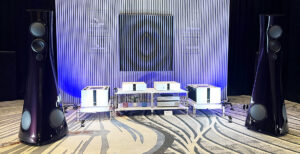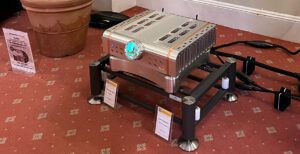
A loudspeaker is untimately just a balance of compromises: ask any experienced listener, engineer, or reviewer! This is because the process of transducing an electrical signal into an acoustic one is, despite over a hundred years of development, still not a perfect science. Making a device that can sit in a living room and reproduce everything from a full-scale orchestra to the human voice, and all points in between with equal accuracy, is a herculean task. Which was perhaps why in the late 1960s, Yamaha made the NS20, a speaker with a very large rectangular driver on the back that was designed to emulate a cello by approximating its size and shape. Neat idea, but what chance did that have of reproducing an organ or bass guitar without screwing up.
The sheer difficulty of the job that a loudspeaker has to do has led to a diverse array of solutions. The first loudspeakers were simple horns, which still have a following today because nothing else can deliver dynamics and speed in quite the same way. Next came the infinite baffle with a conical driver, the simplest and least expensive solution, and the one which ultimately has proved most enduring.

The loudspeaker has come a long way since its introduction in the late 19th century, albeit not perhaps as far as the early pioneers of the technology might have imagined given the pace of change at the time. The moving coil transducer was patented in 1874, and the first conical diaphragm in 1901. Rice and Kellogg came up with the principle of the direct radiator in 1925, and Kellogg filed a patent for an electrostatic speaker in 1929. Even the first two-way loudspeaker appeared in 1931, and the acoustic suspension system, cornerstone of every small box loudspeaker ever since, dates back to 1954. Engineers now largely refine these principles than trying to start afresh, in an attempt to iron out their shortcomings and improve bandwidth, linearity, and power handling.
Despite all this time it’s still hard to get designers to agree on the best approach to building the perfect loudspeaker. Listen to a loudspeaker from Bowers & Wilkins and one from Focal, their French opposite, and while there are plenty of similarities there are nearly as many differences, especially when it comes to agreement on how to do the job. This is partly due to marketplace realities: the fact that end users have differing tastes and differing systems in widely differing rooms. A variation makes for a very complex algorithm for building a commercially successful loudspeaker.
Ideally a loudspeaker should not add or detract from the signal, it should instead act as an electro-mechanical transducer that turns a voltage into vibration in the air. To best achieve that it is desirable that the only bits of the loudspeaker that moves should be the drive units, yet as the drive units have to vibrate to do the job, this energy will be reflected in vibrations in the enclosure that support the units. There have been and continue to be numerous attempts to combat this source of colouration, including cabinet materials like aluminium, GRP, concrete, and all manner of combinations and unusual approaches. Vivid loudspeakers, for example, combine GRP skins with a filling of end-grain balsa to achieve low mass and high stiffness: the lower the mass, the less capacity it has to store energy, and the quicker that energy can be dissipated. The opposite approach is best exemplified by concrete, where high mass is used on the premise that it is difficult to excite at audio frequencies. Its scarcity of use, however, indicates that practicality and aesthetics are as important as sonic theory. There are however plenty of high mass designs on the market that use more attractive materials such as aluminium from the likes of Magico and and it’s a popular school of thought.
Wood (or wood-fibre based MDF) is, however, the material of choice for most. It is easy to fabricate with, has a character that we are accustomed to, and can be finished in a style that appeals to the average buyer. The fact that it is made of similar material to acoustic instruments, and thus joins in with the sound at certain frequencies, is just one more challenge for the designer.
Ideals
What most would agree is required of a loudspeaker is the following: flat frequency response, wide bandwidth, even dispersion, high power handling, low colouration, and of course minimal distortion, which would theoretically be the result if all of the above were achieved. But building a loudspeaker that does all that often involves conflicting requirements. The electrostatic loudspeaker first put into production by QUAD in 1957 got remarkably close to several of the goals by delivering vanishing levels of coloration in the context of a remarkably even frequency response. However, it did not produce the sort of power in the bass required by amplified music, a situation that has rarely been fully addressed. Given inherent design challenges, many electrostatic loudspeaker manufacturers have turned to hybrid designs, which combine the panel with a moving coil bass driver, but the difference in dispersion and dynamic characteristics make such designs very difficult to build, even at high-end prices.

While not totally essential to the end, high power handling is a very desirable quality that provides the potential for higher and more realistic volume levels. While few would want the full power of an orchestra or rock band in our living rooms, there is little doubt that SPLs are a key part in creating a realistic facsimile of live music. Low sensitivity systems require so much power to deliver high SPLs that they need an amplifier the size of a power station, but loudspeakers with a sensitivity figure better than 90dB/Watt at one metre often struggles to maintain a flat frequency response. Some balance is required.
Ways and means
Even in a direct radiating loudspeaker, there are a lot of variables to juggle. The first decision that needs to be made is whether to build the cabinets as a sealed/infinite baffle, reflex loaded/ported, or transmission line. Reflex loading is by far the most popular option. It gives greater power handling and greater measured bass extension, because the output from the port contributes to the overall output. Sealed boxes tend to be less able to sustain high SPLs but have cleaner bass than reflex designs, because it’s difficult to completely eliminate distortion from a port. Meanwhile, transmission lines offer sealed box bass quality with reflex style power handling, but are less common, perhaps because they are harder to get right. The software that exist for ported enclosure design is extremely sophisticated and does most of the R&D for you, but this is not available for TLs. There is a subset of reflex loading called ABR (auxiliary bass radiator) where an unpowered driver is used in place of a port, a design created to address the problems of reflex loading without the complexity of a transmission line.

Once you have decided on how to build your box the next decision would be how many ways to split the signal. The easiest and most appealing in many respects is to go for one way with a single driver. This gives instant coherence of timing, but it also limits bandwidth quite seriously. Go for a two-way and you can extend bandwidth significantly, but you then need to split the signal with a crossover, which means a decision about the steepness of slope; 6, 12, 18 or 24dB dB/octave (first, second, third, fourth order). And that creates a multitude of options given that capacitors and inductors vary in sound from one brand to the next.
You can easily go up to four-way designs, the more ‘ways’ a speaker has, the narrower the frequency range that each driver has to reproduce, and thus the higher the power handling. This means more complex, fourth order crossovers, which as Peter Thomas of PMC puts it are, “an absolute b*#$@&%d” to design, because they require more components and these parts are inclined to ring; a midrange crossover has to roll off both the top and the bottom of the signal, and they can easily interact. Peter Thomas also points out that any crossover can be made to sound good if the designer “knows his onions”, so it’s much like any other side of speaker design. The popularity of lower-order designs boils down to the fact that it’s considerably easier to design a first or second-order crossover than it is a third or fourth.
Along with deciding how to split the signal across multiple drive units comes the challenge of finding or developing drive units that can deliver that signal with as little distortion as possible. The array of choices here is not bewildering, but it is pretty big, even if you discount ribbons, electrostatic film and planar magnetic strips that Magnepans use. There remain a number of different options for cone and dome materials and an even greater range of motor system variations (magnets, voice coils, pole pieces, etc.). When it comes to cone materials, you mostly work with the old favourites of paper, plastic, and metal, but within that there are considerable variations, such as Focal’s sandwich cones with glass reinforced plastics over a foam core and Bowers & Wilkins’ use of Kevlar. The former is extremely stiff and the latter relatively pliant, but both can be engineered to produce a very fine result. Paper is popular because it’s offers a good combination of low mass, stiffness, damping, and price. Tweeters are largely limited to soft fabric domes or aluminium ones but there is a contest going on to see who can make the lightest and stiffest dome, Bowers & Wilkins has diamond and Focal Beryllium. Magico has both!
It’s not what you do
As Pete Thomas points out, “it’s not the approach you use but how good you are at implementing it that makes the difference between good and less good speakers”. Anyone can stuff a pair of drivers and a crossover in a box and it will produce sound, but as we all know that is only the beginning. When it comes to loudspeakers, the elephant in the room is, er, the room. Building a speaker that measures well in an anechoic chamber is very different to coming up with a speaker that works in rooms with widely varying dimensions and acoustic characteristics. One of the big reasons why small two-ways are very popular is that they don’t produce a lot of low frequency energy, and thus are less likely to excite the room modes that can muddy the most transparent of midranges. It’s also the reason why the best sounding rooms at hi-fi shows tend to have smaller speakers in them: bass is an all encompassing beast that takes a lot of taming if the walls are made of cardboard.

Interface
As well as interfacing with the room acoustically, loudspeakers interact with the floor beneath them. For a long time, the accepted wisdom has been to have spikes on the speaker’s undersides that effectively nail them down. This allows them to sink certain frequencies into the floor and minimises vibration at low frequencies, which means that more energy is transmitted into the floor and thence into the source and amplification. There is another school of thought that isolation is a good thing for loudspeakers: you can see it in the way Bowers & Wilkins decouples its tweeter pods with highly compliant mountings and other brands use similarly soft gaskets to stop driver chassis from exciting the surrounding cabinet. Townshend Audio makes damped spring supports that attempt to isolate the whole speaker from the floor which seem to be highly beneficial. It is clearly time that the spiking ethos was re-evaluated.
Choice and place
So there you have it: a riddle, wrapped in a mystery, inside an enigma*. Loudspeaker design is a series of choices with very little in the way of an absolute sound agreed upon. The state of the art has come a long way, however, and you can get some pretty remarkable speakers for less than the price of a family outing to Legoland. Distortion levels are constantly dropping and fit and finish improving at an impressive rate; all you have to do is find a pair that works in your system, your room, and with your music,. Often the key to that lies in placement and set-up as much as actual hardware. An hour or so finding the best place for your speakers will reward you with years of top flight entertainment.
*(Churchill’s description of what to expect of Russia at the beginning of the second world war)
Tags: FEATURED
By Jason Kennedy
More articles from this authorRead Next From Blog
See all
AXPONA 2024 Show Report Part One
- Apr 19, 2024

Audio Show Deluxe 2024: A photo show report
- Mar 28, 2024

Paul Messenger 1949-2024: A personal tribute
- Mar 26, 2024

Bristol Hi-Fi Show 2024: See You There!
- Feb 21, 2024










